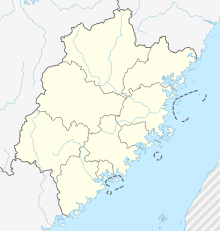
Back جينجيانغ Arabic Céng-gŏng CDO Jinjiang (kapital sa gatos sa Pangmasang Republika sa Tśina, Fujian Sheng) CEB Jinjiang Welsh Jinjiang (Quanzhou) German Jinjiang (Quanzhou) Spanish جینجیانگ Persian Jinjiang French Chin-kông-sṳ HAK Jinjiang ID
Jinjiang
晋江市 Tsinkiang | |
|---|---|
| City of Jinjiang, City of Quanzhou, Province of Fujian | |
 Jinjiang | |
 Jinjiang in Quanzhou | |
| Coordinates (Jinjiang municipal government): 24°46′54″N 118°33′06″E / 24.7816°N 118.5517°E | |
| Country | People's Republic of China |
| Province | Fujian |
| Prefecture-level city | Quanzhou |
| City seat | Luoshan Subdistrict (罗山街道) |
| Area | |
• Total | 721.7 km2 (278.6 sq mi) |
| Population (2020 census) | |
• Total | 2,061,551 |
| • Density | 2,900/km2 (7,400/sq mi) |
| Time zone | UTC+8 (China Standard) |
| Postal code | 362200 |
| Area code | 0595 |
| Website | www.JinJiang.gov.cn |
Jinjiang City (Chinese: 晋江市; pinyin: Jìnjiāng; Pe̍h-ōe-jī: Chìn-kang) is a county-level city under Quanzhou City, Fujian Province, China. It is located in the southeastern part of the province (Minnan), on the right or south bank of the Jin River, across from Quanzhou's urban district of Fengze and Licheng. Jinjiang also borders the Taiwan Strait of the East China Sea to the south, and Quanzhou's other county-cities of Shishi and Nan'an to the east and west, respectively. It has an area of 721.7 square kilometres (278.6 sq mi) and a population of 2,061,551 as of 2020.[1][2]
Jinjiang has the only extant Manichean temple in China (Cao'an temple) and is near the eastern end of the world's longest estimated straight-line (great circle) path over land, at 11,241 km (6,985 mi), ending near Sagres, Portugal.[3]
- ^ "Profile of Jinjiang" (in Chinese). 2010 Census.
- ^ "China: Fújiàn (Prefectures, Cities, Districts and Counties) - Population Statistics, Charts and Map". www.citypopulation.de. Retrieved 2024-10-30.
- ^ MIT Technology Review – Computer scientists have found the longest straight line you could sail without hitting land
